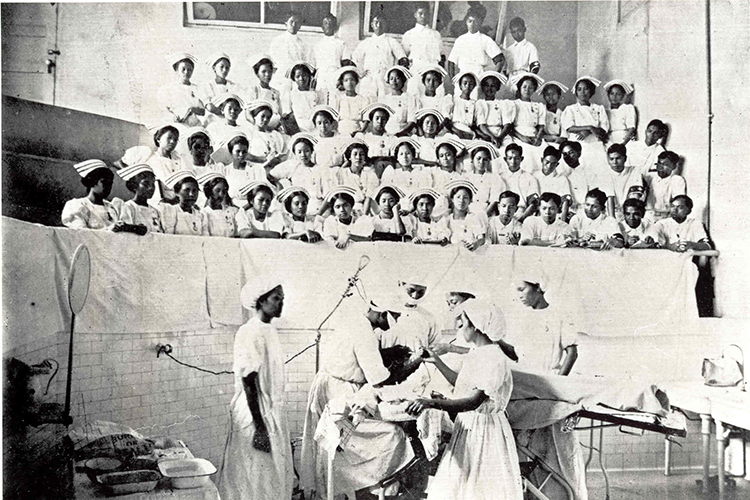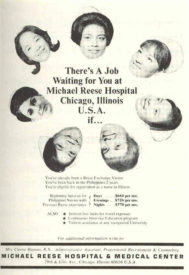Why are there so many Filipino nurses in the U.S.?
In her book, Empire of Care, ethnic studies professor Catherine Ceniza Choy explains how the wave of Filipino nurse immigration started in the early 20th century
May 28, 2019
Growing up in New York City, UC Berkeley ethnic studies professor Catherine Ceniza Choy remembers seeing a lot of nurses dressed in their crisp white uniforms. She and her mom lived in an apartment building near several hospitals, so seeing health workers in the community wasn’t unusual.
But she also noticed that many of the nurses were Filipino.
Years later, as a graduate student at UCLA, Choy began to wonder: Why were there so many Filipino nurses in the U.S.? What she found took her back to the early 20th century after the Philippines became a U.S. colony.
Following is a written version of Fiat Vox episode #55: “Why are there so many Filipino nurses in the U.S.?”
[Music: “Balti” by Blue Dot Sessions]
Growing up in New York City, UC Berkeley ethnic studies professor Catherine Ceniza Choy remembers seeing a lot of nurses dressed in their crisp white uniforms. She and her mom lived in an apartment building near several hospitals, so seeing health workers in the community wasn’t unusual.

Catherine Ceniza Choy is an professor of ethnic studies at UC Berkeley. (UC Berkeley photo by Irene Yi)
But she also noticed that many of the nurses were Filipino.
Her mom was an immigrant from the Philippines. And when they’d go to Filipino events, it was common to see a lot of nurses.
“I think when I was growing up, it was just part of the familiar landscape of home,” Choy says, “and what it was like to be in New York City. I didn’t really question it as a child. It just seemed natural or normal to me.”
Years later, as a graduate student at UCLA, Choy began to wonder: Why were there so many Filipino nurses in the U.S.?
So, she began to research the subject and soon realized there wasn’t much information about it. Most of the literature was focused on how the Immigration and Nationality Act of 1965 caused an influx of foreign-born nurses to the U.S., including those from the Philippines, who were helping to fill the critical shortage of nurses after WWII ended.
“But that explanation didn’t answer the question regarding why the Philippines because this immigration was open to professionals and to potential nursing immigrants around the world,” she says. “So, why the Philippines?”
[Music: “Alchemical” by Blue Dot Sessions]
Choy, then a Ph.D. student, began to investigate.
As part of her research, she traveled to the Philippines. She did archival research in Manila at various universities and schools of nursing. She even audited a beginning nursing class at St. Luke’s College of Nursing, where she learned with nurses-in-training, making beds and going on public health missions to poor neighborhoods.
And when she got back to New York City, she conducted more than 40 in-depth oral interviews with Filipino nurses who had immigrated to the U.S. This was in the 1990s. Many of the nurses she interviewed had come to the U.S. 20 or 30 years before.

Georgia Rabara (left), an ethnic studies major at Berkeley, took Choy’s course on Filipino American history last year. The class read Choy’s book Empire of Care, in which Rabara was surprised to read about her great auntie Mila, a nurse who immigrated to New York City from the Philippines in the 1960s. Mila was one of the more than 40 nurses Choy interviewed as part of her research. (UC Berkeley photo by Irene Yi)
“One of my major findings in my research was that really the first mass wave of Filipino nurse migration to the United States takes place in the 1960s, but it takes place under the auspices of what was called the Exchange Visitor Program.”

Rabara (right) and her great auntie Mila, who immigrated from the Philippines to work as a nurse in New York City. “In Empire of Care, I read about how Auntie Mila’s mom used her life savings to send Mila to the U.S.,” says Rabara. “It was really shocking and endearing to see that. It shows just how far family will go for you to make your life better than their lives.” (Photo courtesy of Georgia Rabara)
The Exchange Visitor Program was created in 1948 to bring people from other countries to the U.S., where they would work and study for two years, and learn about American culture. The program didn’t specifically target the Philippines or nurses. Rather, it was created to combat Soviet propaganda during the Cold War by exposing foreigners to U.S. democracy.
“The intent was to learn about the progressive ways of the United States, and then the exchange visitors would return to their countries of origin and sort of serve as U.S. cultural ambassadors because of their experience in the United States,” says Choy.
Filipino exchange nurses and other health care workers soon began to dominate the program.
But it still didn’t answer: why the Philippines? Turns out, the reason goes back to the early 20th century.
[Music: “Cloud Line” by Blue Dot Sessions]
Soon after the Philippines became a U.S. colony in 1898, the U.S. implemented American nursing programs in the Philippines.
“This Americanized nursing curriculum inadvertently prepared them to work in the United States. They were trained, oftentimes, in English instruction. Even their early nursing licensure examinations had an English language component.”

A senior class receives instruction in operating room techniques at the Philippine General Hospital. (Photo from the Philippine General Hospital School of Nursing Ninth Annual Announcement and Catalogue, 1915-1916, U.S. National Archives, College Park, MD.)
Euro Americans still followed the 19th century idea of Manifest Destiny — that they had a God-given right to expand westward because they were bringing Christianity and civilization.
“And so, it’s this kind of racial hierarchical attitude that influenced their decision that in order to uplift Filipinos, we need to educate them in American ways,” says Choy. “And that includes not just American education on the elementary and secondary levels, it also includes Americanized education at the college and university level and it includes Americanized nursing training.”
So, to recap: In the early 1900s, the U.S. set up nursing schools in the Philippines that taught an American curriculum in an effort to “civilize” the Philippines.

In this ad in the 1969 issue of the Philippine Journal of Nursing, Michael Reese Hospital and Medical Center urges its former exchange visitor nurses from the Philippines to return for permanent employment. (Image courtesy of Catherine Ceniza Choy)
Then, in 1948, just two years after the Philippines gained independence from the U.S., the U.S. created the Exchange Visitor Program, which allowed foreign professionals to come to the U.S. for two years to help spread American democracy across the world and fight Soviet propaganda. Many Filipino nurses, already trained in American-style nursing, came to the U.S.
Then, in 1965, the Immigration and Nationality Act was passed, which allowed a larger number of immigrants from around the world to come to the U.S. There was a critical shortage of nurses following WWII and U.S. hospitals started advertising for Filipino nurses.
“One of my favorite primary sources that I used were these advertisements in the Philippine Journal of Nursing that had been placed by U.S. hospitals urging them to come back to the United States because now there was immigration legislation. These advertisements would publicize their salaries in U.S. dollars and it would portray immigration as a form of travel and adventure for these nurses.”
[Music: “When in the West” by Blue Dot Sessions]
Choy says the Philippines continues to be the leading exporter of professional nurses to the U.S., although the ways they immigrate have changed over time. About one-third of all foreign-born nurses in the U.S. are Filipino. Since the 1960s, there have been over 150,000 Filipino nurses who have migrated to the U.S.
And today, it’s not solely Filipino immigrants who are nurses, but also multiple generations of U.S.-born Filipino Americans who are also nurses.

After Rabara graduates next year, she plans to attend nursing school. “I’ve always wanted to go into nursing, just like my auntie Mila — and, actually, my mom and my grandma,” she says. “I feel like I’m continuing their legacy. It feels like a natural thing to do. The fact that you can get paid for taking care of another person is pretty cool.” (UC Berkeley photo by Irene Yi)
Choy says that while training Filipinos in American nursing began as a way to spread American culture to the Philippines, it has also brought Filipino culture to the U.S.
“We often think about the Philippines as an extension of the United States, as a colonial possession, as an extension of U.S. ideology regarding Manifest Destiny. But what we ought to think about is how the United States is also an extension of the Philippines.”
The United States is a dynamic country, she says, that changes people. And the people who are here change all of us.
Choy is the author of the 2003 book, Empire of Care, about her research on nursing and migration in Filipino American history.
Listen to other Fiat Vox episodes: